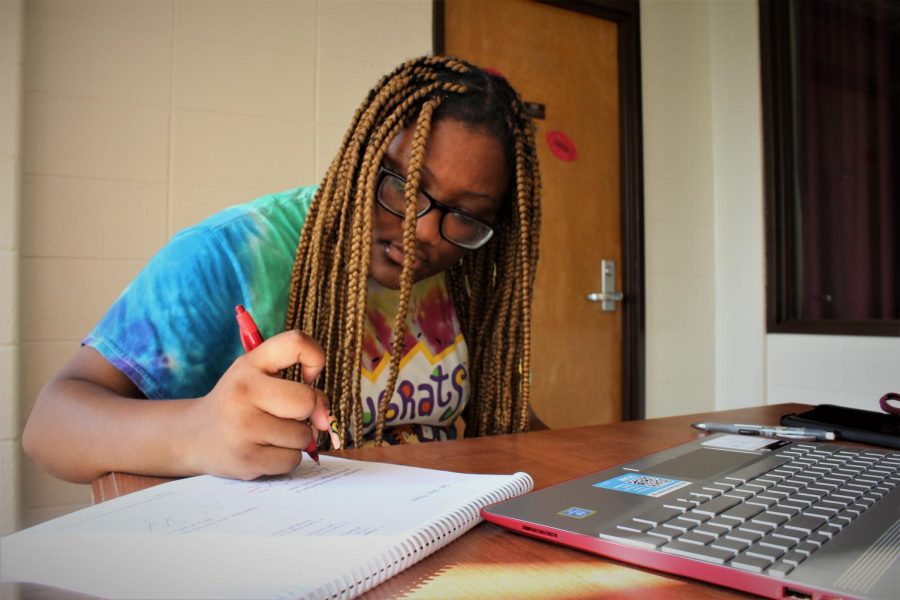Students with different learning styles challenge professors creativity
Alayna Hinman | @ahinman_photos
Jada Brown, a freshman majoring in cinema, does her homework in Kellogg Hall Aug. 27, 2021, in Carbondale, Ill.
Students at SIU-C have a wide variety of learning styles, and some fear they are overlooked and unable to express their full potential in traditional and virtual class settings.
Mikenzi Bushue, a junior English and history major, said students in her classes are often bored and disengaged because they are simply being fed information rather than being able to discuss and ask questions.
“Often entry level classes, labs or the required method classes such as instructional writing classes for my major are not able to adapt to different learning styles,” Bushue said. “They have information they need to teach and usually have a set way on how they teach it.”
Advertisement
Pinckney Benedict, a creative writing teacher at SIU-C, believes many of the bored and disengaged students fit within the classification of “mute inglorious Miltons,” an idea originating in 1751 which implied many people go their entire lifetimes without ever having the opportunity to show their brilliance.
The phrase comes from the poem “Elegy Written in a Country Churchyard” by Thomas Gray, an 18th Century English writer.
In Pinckney Benedict’s classes at SIU-C, it’s not uncommon for students to produce podcasts, Tik Toks, narrative video games and other non-traditional media to showcase their talents.
SIU-C’s Center for Learning Support Services coaches students from three basic learning styles: visual, auditory and kinesthetic. Bushue said she believes there are many more branches of learning styles beyond these, as she and each of her friends learn in very different ways.
Bushue described her style of learning as “interpersonal,” and she said online classes were a struggle for her.
“I am a very social person, and online learning doesn’t have the opportunity for that. There was a disconnect from everyone that was hard to adjust to. Also, I like having a schedule or routine, and with learning online, there was more of an opportunity to just do whatever I wanted,” Bushue said.
Samantha Politzki, a junior forestry and horticulture major, said she does not identify with any officially defined learning style; instead, she believes the location of her classes is the most important factor. She said she prefers outdoor classes where students have the freedom to stand up and move around.
Advertisement*
“I learn better when I’m outside or moving. It’s hard for me to stay engaged indoors,” Politzki said.
Politzki’s learning style of being outdoors and in motion was validated by a study by Harvard Health, “More Movement, Better Memory,” from May, 2021, which concluded many people who exercise while learning show a greater ability to rearrange and reconfigure nerve connections in their brain, allowing them to better retain information.
For students like Politzki, the virtual class format in which most 2020 classes were held offers more freedom to move.
The CDC released an article in August, 2020 called “School Changes – Helping Children with ADHD,” which claimed learning from home has also been beneficial for students who struggle with attention deficit disorders and thrive in more comfortable settings.
“Virtual learning may provide fewer distractions for children who find it more difficult to tune other people out around them,” the CDC said in the article.
Though different formats of classes throughout the pandemic have been helpful to different individuals, Bushue and Politzki agree it is very difficult to learn in the midst of uncertainty.
Despite the struggles of teaching classes in new formats, Politzki said there are still professors who are passionate and hard at work adapting for students of all different learning styles.
“It all depends on how patient and compassionate the professor is,” Politzki said.
Staff reporter Elena Schauwecker can be reached at eschauwecker@dailyegyptian.com.
To stay up to date with all your southern Illinois news, follow the Daily Egyptian on Facebook and Twitter.
Advertisement














